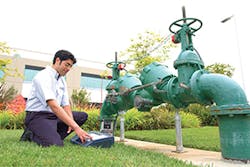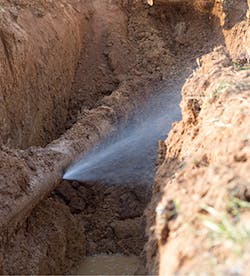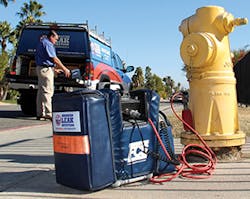According to American City & County Magazine, US utility systems lose more than $8 billion every year in what is known as non-revenue-producing water—water that is lost to leaks and not delivered to customers.
Utilities in the US spend about $900 million every year in capital expenses—usually in the form of repairs—related to this non-revenue-producing water, according to American City & County.
Providence Water, the public water utility based in the city of Providence, RI, is no small operation. The utility serves more than 17 cities and towns, providing more than 60% of the state’s drinking water. The utility relies on more than 950 miles of piping to deliver this water.
With so many pipes, leaks happen. Finding and repairing these leaks, though, before they grow into larger and more costly problems, can be a challenge.
To uncover leaks in the past, Providence Water crews would conduct system-wide leak surveys every 10 years. This was far from ideal, with Providence Water discovering only the most obvious leaks. The utility calculated that 11.6% of the water that it pumped into the system’s pipes ended up as non-revenue water. That came out to a yearly loss of more than $954,000.
Then there were the additional costs of undiscovered leaks. Once, a mainline blowout took place under a state road. It cost $45,350 to repair the leak and restore the road.
The evidence made it clear: Providence Water needed a better method to detect leaks. It needed one that would find leaks quickly, lowering the amount of water it lost each year and preventing smaller leaks from growing into larger ones or full-blown blowouts.
The utility, like many others, turned to advanced acoustic leak detection.
A growing number of utilities are making the same choice. That’s because acoustic leak detection—which, as its name suggests, uses sound technology to help municipalities discover leaks that might otherwise elude detection—can save utilities a significant amount of dollars each year.
Acoustic leak detection can help utilities find leaks quickly. And, it’s a far better alternative than the method that too many utilities still use to find their leaks: walking the system and looking for water that’s risen to the surface.
This, of course, only finds the most obvious leaks. It doesn’t uncover those leaks that are still hidden underground, that cost utilities revenue-producing water, and potentially grow into larger leaks that can result in ruptured streets and major repair jobs.
“Walking the system manually is really the other alternative to acoustic leak detection,” says Jack Merrell, senior marketing manager with Itron. “The utilities I’ve worked with in the past either walk the systems themselves or hire an external company to audit their system every few years. They’ll walk around with a listening device to audit each pipe in their service territory.”
Other utilities do not even schedule regular walk-throughs, Merrell says. Instead, they only audit their systems when they discover physical evidence of a leak.
“A leak will surface and they’ll walk the system,” says Merrell. “It really depends on the utility and the part of the country you are in. But those utilities that aren’t using acoustic testing are usually just walking the system looking for problems. It’s not an ideal way to find leaks.”
Tackling the problem
Providence Water is one of those utilities that wanted a better way to find leaks. It had suffered enough water losses so that officials with the utility were ready to make a change. That change came in 2010, when the utility invested money it had received from the American Recovery and Reinvestment Act into an acoustic leak detection system from manufacturer Itron.
The system included Itron’s MLOG Radio sensors, which are acoustic sensors, and the company’s mlogonline Network Leak Monitoring System. The MLOG sensors provide continuous monitoring of a utility’s distribution system.
Itron’s meters are permanently affixed to the supply side of Providence’s water meters. Because of this setup, Providence Water crews can capture leak detection numbers when they are charting their normal meter reads.
Providence signed on for the deployment of 9,400 MLOG sensors beginning in March 2010. At the same time, the utility began using the mlogonline monitoring software. The vast majority of sensors were in place by May 2012.
Kevin DiNobile, a manager with the water utility, says that the benefits of the leak detection software came quickly. As of June 2012, he says, the utility was tracking 167 possible water leaks. Crews investigated 72 of these potential leaks and drafted 31 work orders for pipe repairs. These first 31 repair jobs, alone, resulted in the recovery of more than 31 million gallons of revenue-producing water every year.
The STAR ZoneScan from Aclara is a good example of how these acoustic monitoring systems work.
According to Aclara, utilities install acoustic loggers at regular intervals throughout their systems. They attach the loggers to valves using the loggers’ magnetic base. Once installed, the loggers monitor and analyze the noise throughout the pipe network to detect leaks.
Utilities can either use the Zone-Scan monitors as a stand-alone system or they can integrate the system with their Advanced Metering Infrastructure—better known as AMI—systems to better analyze the data that the loggers provide.
With the loggers, utilities can track leak information in real time. As Aclara says, this can allow utilities to save on fuel costs. Armed with this real-time leak information, utilities can send out repair crews to targeted areas, depending on where these crews happen to be at any time, reducing the amount of time repair crews spend traveling to a leak site.
Acoustic leak detection saves water and resources.
Once the loggers are installed, operators can monitor the system and analyze data at the utility office. This means that utilities will no longer need to rely on manual or drive-by data collection, again saving on both fuel and labor costs.
In a written statement, Allan Connolly, chief executive officer and president of Aclara, says that he expects more utilities to invest in acoustic leak detection. Utilities today are simply losing too much water, he says.
“In many communities, 10 to 20% of water pumped into distribution systems may be lost due to leaks,” says Connolly. “As infrastructure gets older, the water loss may rise to over 50%. From an environmental perspective, this situation wastes a great deal of water, a precious resource that is becoming more valuable every day.”
Seeking Outside Help
Many municipalities that haven’t yet invested in their own acoustic leak detection systems hire outside consultants at companies such as American Leak Detection. This company operates throughout the US and in Australia and Canada, sending out technicians to walk the water distribution systems of municipalities that are hunting for leaks.
Jimmy Carter, senior director of corporate field services with American Leak Detection, says that more water utilities are either investing in their own acoustic leak detectors or are hiring companies like his to better identify leaks throughout their systems.
“It really depends on the utility,” says Carter. “The size of the utility and the funding available to it make a big difference. We do work with utilities that are thinking about investing in their own leak detection systems, if they receive grant funding that they’ve applied for. But then there are the smaller, rural districts out there. They usually don’t have the manpower or the funding for a leak detection system.”
It still remains that the larger water utilities—especially those in drought-prone areas—are investing in acoustic leak detection, Carter says.
“The larger utilities are trying to be more proactive when it comes to leaks,” says Carter. “They have the funds to invest and they are trying to stay on top of their systems.”
Other Benefits
Reducing non-revenue-producing water is a key benefit of acoustic leak detection. But it’s not the only one.
As Merrell says, many utilities rely on acoustic leak detection to help maintain the health of their pipes and infrastructure. By finding leaks quickly—and before they grow even larger—utilities can pinpoint those areas of their water-delivery system that need the most attention.
By assigning work crews to the pipes most in need of repair, utilities can preserve the lifespan of their infrastructure.
“That is a benefit that doesn’t always get as much notice as it deserves,” says Merrell. “It is as much about reducing non-revenue water as it is about sustaining the health of the system. Maintaining the system will become more of a factor, I believe, as we move forward. There is more concern overall for our water supply around the country.
“The alternative to acoustics, is to take a snapshot in time of a system every year. Monitoring it every single day, which we do with acoustics, is a better solution. That way you can keep your finger on the pulse of your system and maintain its health or improve it in a much more timely manner.”


